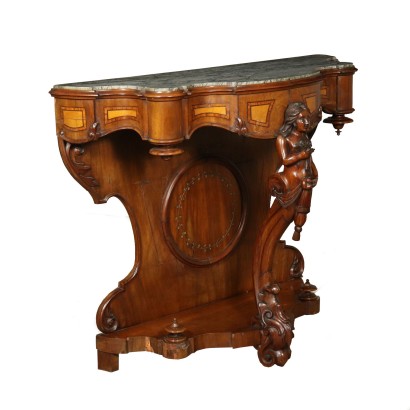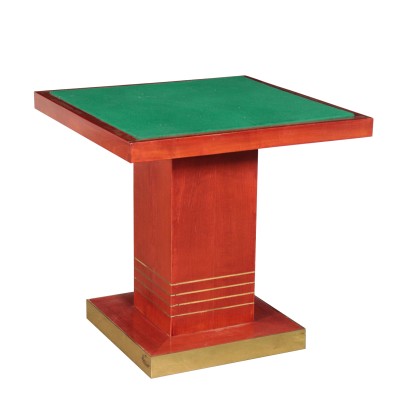Louis Philippe Console Table Marble Top Italy Mid 1800s
Features
Style: Louis Philippe (1830-1848)
Age: 19th Century / 1801 - 1900
Origin: Italy
Main essence: Maple , Brazilian Rosewood , Mahogany
Material: Mahogany Veneer
Description
Louis Philippe console table with carved caryatid. Serpentine shape with turnings and inlays. Marble top. Manufactured in Italy, mid 19th century.
Product Condition:
The item shows signs of wear due to age. Any damage or loss is displayed as completely as possible in the pictures. It may require restoration and recovery of french polish.
Dimensions (cm):
Height: 111
Width: 137
Depth: 62
Additional Information
Style: Louis Philippe (1830-1848)
The Louis Philippe style develops in a context characterized by two main factors: the expansion of the bourgeoisie and the advent of the industrialization of production processes.
This style therefore faces the decline of artisans and the new needs of economy and comfort.
Aesthetically it incorporates elements from the past, especially from the Gothic and the Renaissance, preferring very curved shapes for the seat backs, legs and deer-like feet, with a very rich decoration.
It mainly uses dark woods: ebony, rosewood and mahogany, side by side for contrast with light elements.
Find out more with our insights:
The Louis Philippe style Classic Monday: Luigi Filippo and Umbertina consoles in comparison
Age: 19th Century / 1801 - 1900
19th Century / 1801 - 1900 Main essence:
Maple
Hard, light wood used for inlays. It grows mainly in Austria, but it is widespread throughout the northern hemisphere, from Japan to North America, passing through China and Europe. It is one of the lightest woods ever, tending to white, it is similar to lime or birch wood. The briar is used in the production of ancient secretaires .
Brazilian Rosewood
It is a hard, light blond wood, but with strong red and pinkish veins, which is obtained from tropical trees similar to rosewood. Its veins are reminiscent of striped tulips, which is why it is called tulipwood in English-speaking areas. It is used for inlays, often combined with bois de violette. In the 1700s and 1800s it was highly appreciated and used in France and England for precious veneers. It gives off scent for decades if not centuries after curing.
Mahogany
It is one of the most precious and sought-after woods in cabinet making. It was discovered in Central America around 1600 and began to be imported to England in the 1700s. Much appreciated for its hardness and indestructibility, it became widespread following the blocking of walnut exports from France in 1720 and the consequent elimination of English import duties on mahogany from the colonies in America and India. The most valuable version comes from Cuba, but it became very expensive. At the end of the 18th century it began to be used also in France in Louis XVI, Directory and Empire furniture, its diffusion declined starting from when Napoleon, in 1810, forbade its import. It was generally used in the manufacture of elegant furniture, due to its characteristics and beautiful grain.
Material: Mahogany Veneer































